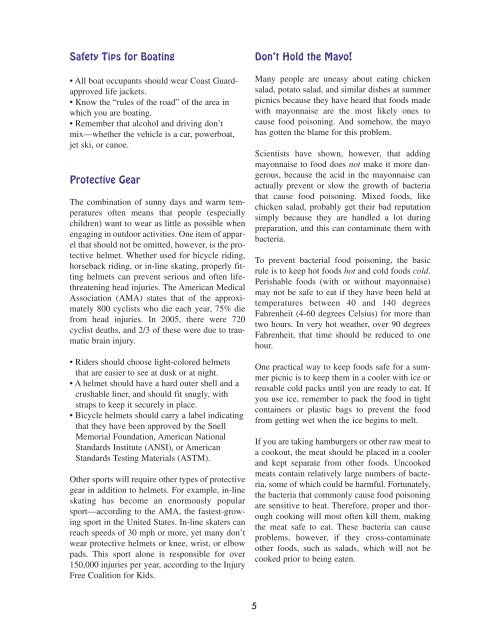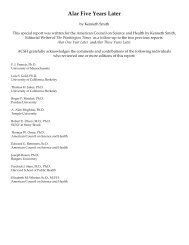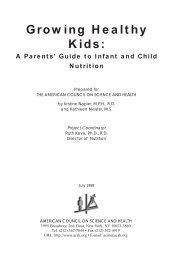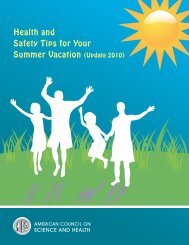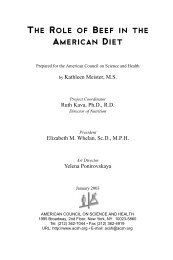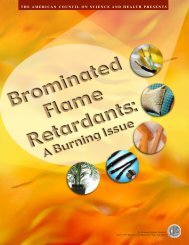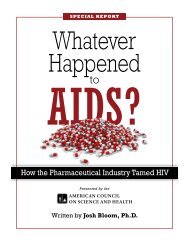View pdf - American Council on Science and Health
View pdf - American Council on Science and Health
View pdf - American Council on Science and Health
Create successful ePaper yourself
Turn your PDF publications into a flip-book with our unique Google optimized e-Paper software.
Safety Tips for Boating<br />
• All boat occupants should wear Coast Guardapproved<br />
life jackets.<br />
• Know the “rules of the road” of the area in<br />
which you are boating.<br />
• Remember that alcohol <strong>and</strong> driving d<strong>on</strong>’t<br />
mix—whether the vehicle is a car, powerboat,<br />
jet ski, or canoe.<br />
Protective Gear<br />
The combinati<strong>on</strong> of sunny days <strong>and</strong> warm temperatures<br />
often means that people (especially<br />
children) want to wear as little as possible when<br />
engaging in outdoor activities. One item of apparel<br />
that should not be omitted, however, is the protective<br />
helmet. Whether used for bicycle riding,<br />
horseback riding, or in-line skating, properly fitting<br />
helmets can prevent serious <strong>and</strong> often lifethreatening<br />
head injuries. The <str<strong>on</strong>g>American</str<strong>on</strong>g> Medical<br />
Associati<strong>on</strong> (AMA) states that of the approximately<br />
800 cyclists who die each year, 75% die<br />
from head injuries. In 2005, there were 720<br />
cyclist deaths, <strong>and</strong> 2/3 of these were due to traumatic<br />
brain injury.<br />
• Riders should choose light-colored helmets<br />
that are easier to see at dusk or at night.<br />
• A helmet should have a hard outer shell <strong>and</strong> a<br />
crushable liner, <strong>and</strong> should fit snugly, with<br />
straps to keep it securely in place.<br />
• Bicycle helmets should carry a label indicating<br />
that they have been approved by the Snell<br />
Memorial Foundati<strong>on</strong>, <str<strong>on</strong>g>American</str<strong>on</strong>g> Nati<strong>on</strong>al<br />
St<strong>and</strong>ards Institute (ANSI), or <str<strong>on</strong>g>American</str<strong>on</strong>g><br />
St<strong>and</strong>ards Testing Materials (ASTM).<br />
Other sports will require other types of protective<br />
gear in additi<strong>on</strong> to helmets. For example, in-line<br />
skating has become an enormously popular<br />
sport—according to the AMA, the fastest-growing<br />
sport in the United States. In-line skaters can<br />
reach speeds of 30 mph or more, yet many d<strong>on</strong>’t<br />
wear protective helmets or knee, wrist, or elbow<br />
pads. This sport al<strong>on</strong>e is resp<strong>on</strong>sible for over<br />
150,000 injuries per year, according to the Injury<br />
Free Coaliti<strong>on</strong> for Kids.<br />
5<br />
D<strong>on</strong>’t Hold the Mayo!<br />
Many people are uneasy about eating chicken<br />
salad, potato salad, <strong>and</strong> similar dishes at summer<br />
picnics because they have heard that foods made<br />
with may<strong>on</strong>naise are the most likely <strong>on</strong>es to<br />
cause food pois<strong>on</strong>ing. And somehow, the mayo<br />
has gotten the blame for this problem.<br />
Scientists have shown, however, that adding<br />
may<strong>on</strong>naise to food does not make it more dangerous,<br />
because the acid in the may<strong>on</strong>naise can<br />
actually prevent or slow the growth of bacteria<br />
that cause food pois<strong>on</strong>ing. Mixed foods, like<br />
chicken salad, probably get their bad reputati<strong>on</strong><br />
simply because they are h<strong>and</strong>led a lot during<br />
preparati<strong>on</strong>, <strong>and</strong> this can c<strong>on</strong>taminate them with<br />
bacteria.<br />
To prevent bacterial food pois<strong>on</strong>ing, the basic<br />
rule is to keep hot foods hot <strong>and</strong> cold foods cold.<br />
Perishable foods (with or without may<strong>on</strong>naise)<br />
may not be safe to eat if they have been held at<br />
temperatures between 40 <strong>and</strong> 140 degrees<br />
Fahrenheit (4-60 degrees Celsius) for more than<br />
two hours. In very hot weather, over 90 degrees<br />
Fahrenheit, that time should be reduced to <strong>on</strong>e<br />
hour.<br />
One practical way to keep foods safe for a summer<br />
picnic is to keep them in a cooler with ice or<br />
reusable cold packs until you are ready to eat. If<br />
you use ice, remember to pack the food in tight<br />
c<strong>on</strong>tainers or plastic bags to prevent the food<br />
from getting wet when the ice begins to melt.<br />
If you are taking hamburgers or other raw meat to<br />
a cookout, the meat should be placed in a cooler<br />
<strong>and</strong> kept separate from other foods. Uncooked<br />
meats c<strong>on</strong>tain relatively large numbers of bacteria,<br />
some of which could be harmful. Fortunately,<br />
the bacteria that comm<strong>on</strong>ly cause food pois<strong>on</strong>ing<br />
are sensitive to heat. Therefore, proper <strong>and</strong> thorough<br />
cooking will most often kill them, making<br />
the meat safe to eat. These bacteria can cause<br />
problems, however, if they cross-c<strong>on</strong>taminate<br />
other foods, such as salads, which will not be<br />
cooked prior to being eaten.


